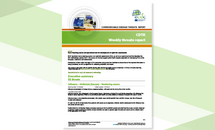Communicable disease threats report, 16-22 March 2014, week 12
The ECDC communicable disease threats report is a weekly bulletin intended for epidemiologists and health professionals in the area of communicable disease prevention and control. Summarising information gathered by ECDC through its epidemic intelligence activities regarding communicable disease threats of concern to
the European Union, it also provides updates on the global situation and changes in the epidemiology of communicable diseases with potential to affect Europe, including diseases that are the focus of eradication efforts.
Executive Summary
The ECDC Communicable Disease Threats Report is a weekly bulletin intended for epidemiologists and health professionals in the area of communicable disease prevention and control. This issue covers the period 16 to 22 March and includes updates on:
Measles outbreak on a cruise ship in the Mediterranean Sea
On 27 February 2014, Italy reported an outbreak of measles on board a cruise ship sailing in the north-western Mediterranean with regular port calls in Italy, Spain and France. As of 20 March 2014, 30 cases of measles have been reported: 29 from Italy and one from Austria. Twenty one cases are among crew members, seven among passengers and two are passengers contacts. Measles viruses of genotype B3 have been isolated from this outbreak. The fragment sequences are identical to a strain associated with an outbreak in the Philippines. The outbreak has not been declared over and new cases among crew and passengers cannot be ruled out. More than 800 crew members have been vaccinated in response to the outbreak. The epidemiological investigations are on-going.ECDC published a Rapid Risk Assessment on 6 March 2014. The Eurosurveillance journal published a preliminary report on the outbreak on 13 March 2014.
Seasonal influenza in Europe
The influenza activity remains at a moderate to low intensity level with stable or decreasing trend in the majority of the EU/EEA Member States and a co-circulation of influenza A(H1)pdm09 and A(H3) subtypes. ECDC published its Annual Risk Assessment on seasonal influenza on 4 March 2014.
Influenza A(H7N9)in China
Between 14 and 20 March 2014, six new cases of influenza A(H7N9) infection have been reported in China. Since March 2013, a total of 394 cases have been reported from China, including 121 deaths. No autochthonous cases have been reported from outside of China. Most cases have been unlinked and sporadic zoonotic transmission from poultry to humans is the most likely explanation for the outbreak. Sustained person-to-person transmission has not been documented. ECDC published an updated Rapid Risk Assessment on 26 February 2014.
Middle East respiratory syndrome – coronavirus (MERS CoV)
Since the previous CDTR, ten new cases of MERS-CoV have been reported in the Middle East. The source of MERS-CoV infection and the mode of transmission have not been identified, but the continued detection of cases in the Middle East indicates that there is an ongoing source of infection in the region. There is therefore a continued risk of cases presenting in Europe following exposure in the Middle East, and surveillance for MERS-CoV cases is essential. The risk of secondary transmission in the EU remains low.
Chikungunya outbreak in the Caribbean
During the past week the number of new chikungunya cases reported increased in some of the affected areas but at a lower rate than the previous weeks the only exception being Dominica. No new affected islands were reported.
Zika virus infection outbreak in the Pacific region
There is an ongoing outbreak of Zika virus (ZIKAV) infection in the Pacific affecting several countries, including Easter Island, a territory administered by Chile. There is a simultaneous dengue outbreak in the region. There is a risk for the disease spreading further both in the Pacific and to the countries of the Americas where the Aedes mosquito is present, and for sporadic imported cases in Europe from endemic areas. There is no available vaccine against ZIKAV infection. Travellers can protect themselves by preventing mosquito bites.
Download






